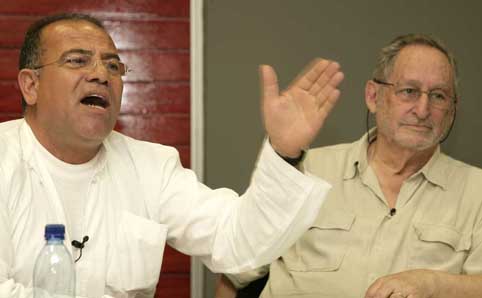 |
|
Bassem Eid (left) and Benjamin Pogrund discuss the situation in the Middle East.
Photo: Johan Roux
15 March 2012
|
Peace is a big word in the Middle East, particularly amongst Israelis and Palestinians. After years of conflict, people yearn for peace; they want an end to the killings and the uncertainty. The problem is that both sides are actively doing things that undermine the prospect of peace. There is also double talk, lies and evasion with each side pointing fingers. This was the word from Benjamin Pogrund, an Israeli peace activist, addressing staff and students on the Bloemfontein Campus of the University of the Free State. He and fellow peace activist Bassem Eid, a Palestinian, visited the campus to speak about the situation in the Middle East.
Both men agreed that peace efforts were hindered by the Israeli and the Palestinian leaders. According to Pogrund, neither the Palestinians, nor the Israelis are leading the way in accepting that the conflict must end.
“Both Israeli and Palestinian leaders say let us get together with no pre-conditions. Then the Israeli leaders say, Jerusalem we cannot share, that is not for negotiation. And, they say to the Palestinians you must recognise Israel as a Jewish state. So, what they say is unless you agree to these pre-conditions there can be no talks without pre-conditions.
“And the Palestinians in turn say the settlement construction must cease immediately, and unless that happened, there is no point in meeting. And they say we will never acknowledge you as a Jewish state so do not even bother talking about it. And we insist on the right of return of Palestinian refugees. So they also say unless you acknowledge these pre-conditions there is no point in meeting with our pre-conditions. So as you can gather each side blames the other side, each side points the finger and says you are responsible for the lack of progress.”
Pogrund said both the Israelis and the Palestinians could demand legitimacy in that part of the world.
“Both Jewish and Arabs can say we have history on our side. We have religion on our side, culture.”
To compare Israel to Apartheid South Africa is wrong, he said.
“It is an occupation, it is repression, but it is not Apartheid.”
Eid, who is the director of the Palestinian Human Rights Monitoring Group, said the Palestinians were close to having a complete independent Palestinian state from 1994 to 1999.
“But in one rocket former Israeli Prime minister Ariel Sharon destroyed it.”
He said Israel’s disengagement from the Gaza Strip in 2005 did not bring political unity.
“We, the Palestinians, were supposed to start building the infrastructure of the Gaza Strip but unfortunately Hamas started dancing on that Israeli disengagement and considered it as their own success because of their military resistance against the occupation.” He also said Hamas is satisfied with its hold in the Gaza Strip and Fatah is also very satisfied with its hold in the West Bank. According to Eid, it is convenient for the Israelis that the Palestinians are separated.